Elevator pitch
Austria is an interesting economy due to its strong industrial relations with institutionalized collective bargaining over wage negotiations and working conditions. Currently, Austria’s GDP per capita is high, but unemployment, although comparably low on an international scale, is not declining in the aftermath of the financial crisis. The labor market is also characterized by an increasing share of mostly low-skilled foreign workers. High marginal labor taxes discourage low-skilled workers from leaving social assistance.
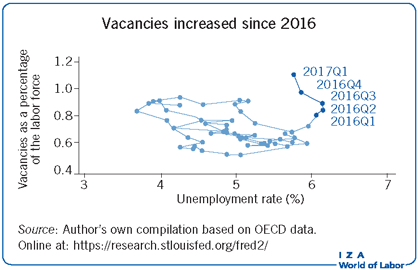
Key findings
Pros
Austria has a high level of GDP per capita.
The unemployment rate is relatively low compared to other developed nations and labor force participation has been increasing since 2004.
Public benefits to compensate for decreased income during short-time work arrangements (i.e. reduced working hours) helped mediate the effects of the financial crisis.
Austria’s dual system of apprenticeship training has led to high youth labor force participation rates.
The gender wage gap in Austria is relatively low by international comparison, and has been decreasing over the past decade.
Cons
The unemployment rate in Austria is currently increasing.
Employer and employee taxes on labor income (the labor tax wedge) were the sixth highest among the 35 OECD member countries in 2016 which dampens labor demand and supply.
The majority of immigrants remain employed in low-paid jobs.
Real wages have been increasing rather slowly.
Since 2013, the share of long-term unemployed people has been increasing at an alarming rate.
Author's main message
Austria’s economy performed reasonably well at the beginning of the century. During the global financial crisis public policy succeeded in keeping unemployment comparably low. However, the recent increase in unemployment has been accompanied by a fall in average working hours and an increase in the number of job vacancies, indicating that the labor market is not operating efficiently. Policymakers should strongly consider reforms to the education system to help improve job–skill matching. Labor taxes should be lowered in order to stimulate both labor supply and the creation of new jobs.
Motivation
Austria’s labor market is interesting due to the presence of strong industrial relations in tandem with a system of institutionalized collective bargaining over wage negotiations and working conditions. Collective agreements cover almost all employees, both in the private and the public sector. Currently, Austria’s GDP per capita is high, unemployment is comparably low, and employment is high. Recent economic performance has benefited from membership in the EU and eastern enlargement. During the crisis, weak labor demand was cushioned by extensive use of short-time work benefits (public income support was provided to workers who worked fewer hours), in addition to other policy programs. The labor market is generally flexible, with relatively weak protections against dismissal and high labor turnover by European standards. Active labor market policies are frequently employed and play an important role in supporting the unemployed to find employment. These policies are accompanied by a generous welfare system. As a result, the income distribution is comparatively equitable and the poverty rate is moderate. During recent years, however, structural problems in the labor market have emerged, in particular, less-skilled people and older workers find it difficult to obtain employment. As a result, the unemployment rate is currently at its highest level since 2000, despite an increasing number of vacancies.
Discussion of pros and cons
Austria’s economy performed reasonably well at the turn of the century. Its unemployment rate of 3.5% in 2000 was one of the lowest in the OECD. Indeed, German newspapers labeled Austria the “better Germany” because of its economic performance. Over the last decade, however, this pattern has reversed, and while Germany’s labor market has improved, Austria’s has worsened. An increase in unemployment has been accompanied by a fall in average working hours, and real wages have been increasing only moderately over the past few years.
Figure 1 provides an overview of the employment and unemployment rates from 2000 to 2015. It shows that the employment rate remained fairly constant throughout the period. Between 2003 and 2004, it declined about two percentage points from 56.9% to 54.8%. Afterwards, it increased until 2008 and has been around 57.5% since. The unemployment rate increased at the beginning of the period from 4% in 2000 to 5.6% in 2005. It decreased between 2005 and 2008, when it fell to 4.1%. Since 2008 it has been increasing and was 6% at the end of 2015. While this level is low by international standards, it is concerning that unemployment has still not fallen in the wake of the Great Recession. Employment gains since 2000 were primarily due to increases in part-time employment, and the inflow of foreign workers, especially following the EU enlargement.
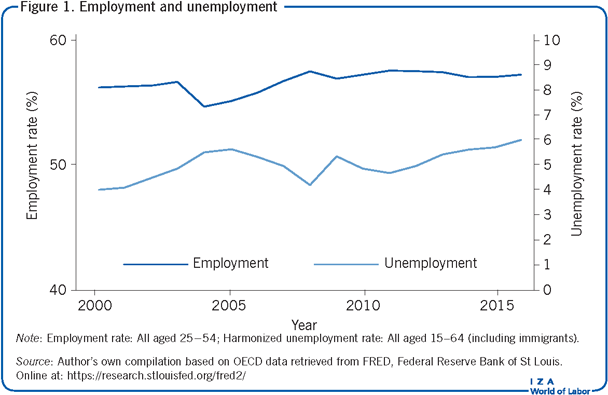
Although the Austrian labor market was impacted by the Great Recession, its effects were relatively small. Several economic policy programs in the form of stability and labor market packages, in addition to EU stability programs, were implemented to counter the negative effects of the crisis. In particular, a program to publicly sponsor short-time work, i.e. a reduction of weekly hours coupled with public transfers to compensate workers for income losses, was expanded in 2009 with the intention of keeping workers in employment and improving their qualifications through training programs. One study estimates that about 6,500 jobs (0.2% of employed people) were saved due to short-time work programs [1]. Employers’ organizations and trade unions, “social partners,” played a key role during this period and were instrumental in implementing the policy packages. Short-time work, for example, requires an agreement with the social partners that a particular economic situation qualifies for short-time employment subsidies and the employment agency has to consult the workers’ representatives (workers in firms with more than five workers have the legal right to elect such a representative).
A more detailed picture of the labor market emerges when disaggregating the unemployment rate by age and gender. Figure 2 reveals that the increase in unemployment after 2011 was predominantly caused by a rise in the number of unemployed (especially younger) men. This was mainly due to pronounced segregation where a large proportion of men work in manufacturing and industry (about 40%), which were more severely hit by the crisis than the service sector, where women tend to work (about 80%).
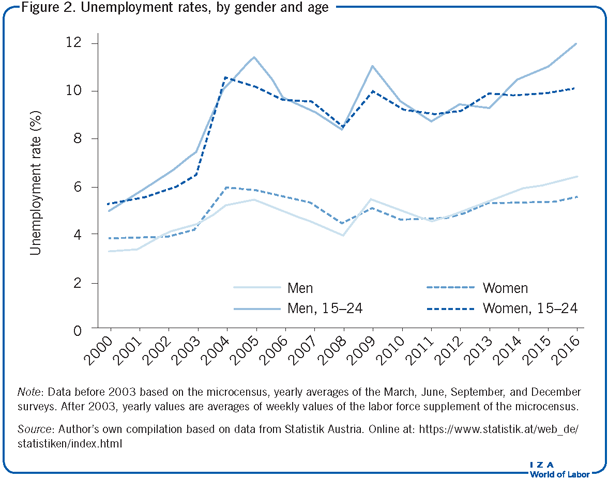
Overall labor force participation has been increasing in Austria since 2004. The main reason for this is the increased participation of older workers (Figure 3), which was prompted by several pension reforms that aimed at increasing the actual retirement age. The average actual retirement age was 58 years for men and 57 years for women in 2000, well below the legal retirement age of 65 for men and 60 for women. For example, among men between the ages of 55 and 65, labor force participation increased from about 40% in 2004 to almost 60% in 2015. Women’s participation today is still below that of men; however, the gap has been narrowing over the last decade. Again, the older cohort has driven this phenomenon, with the labor force participation rate of women between the ages of 55 and 65 increasing dramatically since 2004. In 2009, the government abolished an incentive to hire older workers (via a reduction of social security contributions) as well as a layoff tax for firing older workers, which could have dampened the overall increase. To ease workers’ transition into retirement, the government made it easier for women over 53 and men over 58 to obtain compensation for a drop in earnings if they reduced their working hours.
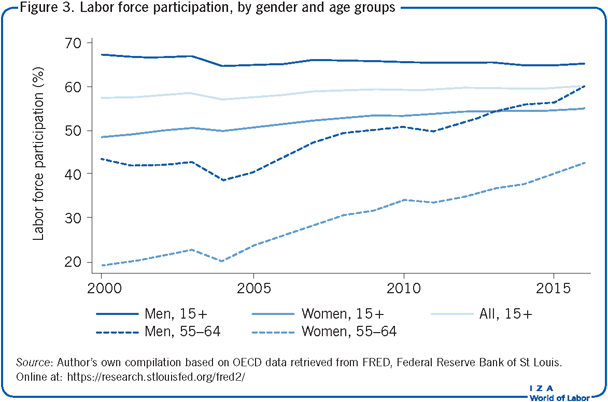
Despite these mostly positive signs, the labor market has been experiencing an extremely troubling trend in the last few years. Since 2013, the share of long-term unemployed persons (i.e. unemployed for 12 months and longer) has been increasing at an alarming rate, as shown in Figure 4. Moreover, it is important to note that the numbers shown in Figure 4 are based on unemployment insurance recipients, and many people who are less attached to the labor market might not be entitled to unemployment insurance benefits for such a long period of time. The recession might have caused many unemployed people to exhaust their benefits; as a consequence, they would no longer be recipients of unemployment insurance. Hence, the actual share of long-term unemployed people may be even greater than the data indicate. Many of the long-term unemployed are older workers who find it particularly difficult to obtain employment. The government intends to re-introduce a tax incentive to hire and a tax penalty for firing older workers. Critics argue that the underlying reason for low labor demand are high labor taxes, both for employers and employees (“tax wedge”), which are proportional on wages, which tend to be higher for older workers.
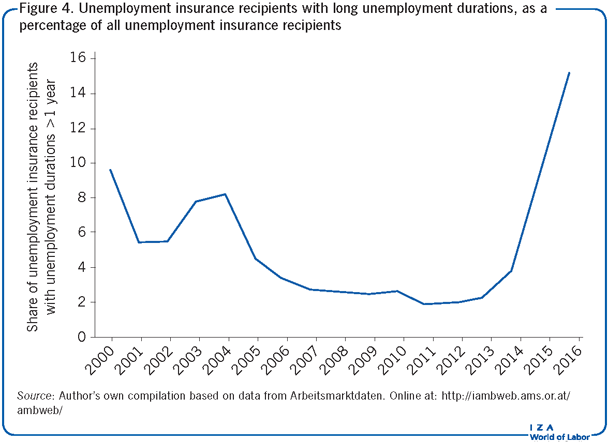
One key event influencing the labor market during the past decade has been the huge influx of foreign workers, who arrived in the wake of EU enlargement. Figure 5 plots the year-on-year population changes for Austrians and non-Austrians. This shows that the Austrian population has remained constant since 2000, while the number of immigrants has increased throughout the period, with particularly large jumps in the early 2000s and early 2010s. At the beginning of 2005, the share of immigrants among the population was around 9%; by 2016 it was close to 15%. The labor market participation rate of immigrants is below that of Austrians (some 66% vs 80%). Many immigrants have low skills, and high unemployment rates might discourage them from participation. For example, in 2016, 45% of all registered unemployed people had at most compulsory schooling [2]. This is also the group whose unemployment rates have increased the most during the last years.
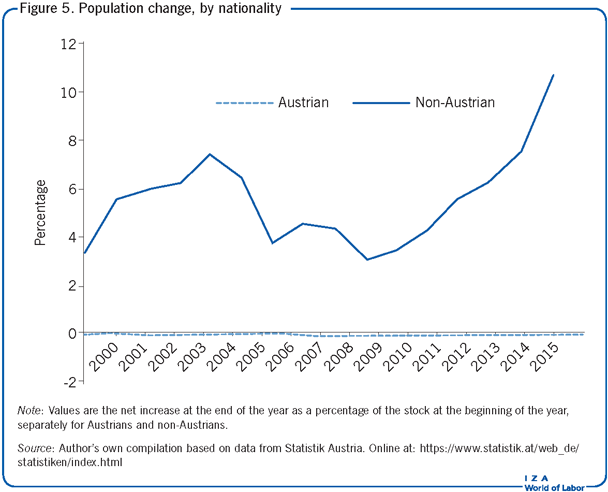
Female immigrants have an even lower labor force participation rate than immigrant men. This could be driven by different attitudes toward male and female roles in society. Female immigrants have, on average, more children than Austrians. Especially outside the bigger cities, it is difficult to combine having children with work as there is a lack of childcare facilities for pre-school children.
Real wages
The evolution of real wages since 2000 is plotted in Figure 6. Wages are measured as the mean full-time equivalent of annual earnings prorated on a monthly basis (since wages in Austria are typically denominated as monthly, with 14 monthly payments), and deflated by the consumer price index. The real wage index declined between 2000 and 2005 and has increased moderately since then. In 2009 wages were at their highest level and declined again thereafter. In 2015, they were, on average, just 3.6% above the 2000 level. This weak growth has in part been driven by minimal wage increases in already low-paid jobs [3]. Especially since the financial crisis, pay for workers in unstable employment (e.g. seasonal work in tourism), has grown significantly more slowly than for workers in stable employment.
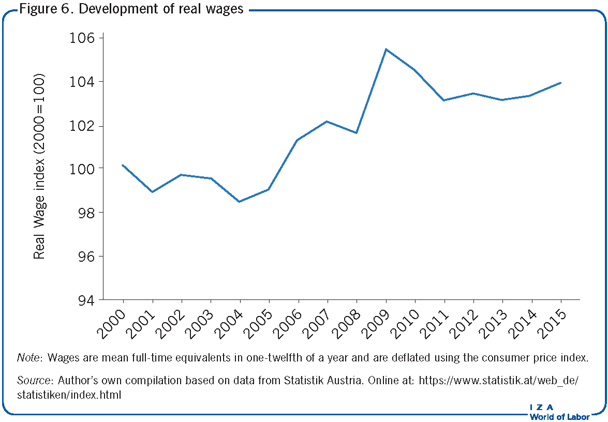
Another troubling indicator for the labor market appears when examining the relationship between job vacancies as a percentage of the labor force and the unemployment rate. The Illustration plots this relationship, which is known as the Beveridge curve, and is typically seen as an indicator of (in)efficiency in an economy. If the curve moves outwards, as it has most recently in 2016 and the first quarter of 2017, this indicates that vacancies have increased for a given level (or even an increasing level) of unemployment, which suggests a growing mismatch between the skills the unemployed possess and the skills which are demanded by employers. In addition, labor turnover in Austria is considerable, with about half of all jobs being replaced every year [4]. Fluctuations differ by sector though, and tourism in particular, with a high share of seasonal employment, has a high fluctuation rate. However, taken together, these facts are alarming, as they imply an increasing inefficiency in the labor market through, for example, a mismatch between demanded and supplied skills.
Youth
Austria is characterized by a so-called dual system of apprenticeship training. This system requires apprentices to spend about one-third of their training in vocational colleges, where they obtain formal qualifications and a recognized certificate [5]. Typically, about 40% of each cohort enters the labor market through an apprenticeship, and about one-third of such entrants are women. Unemployment rates of workers who have completed an apprenticeship are much lower than those who have completed only compulsory education. Young adults who are not in education, employment, or in training (NEET) are comparatively rare, and in 2012 Austria had one of the lowest NEET rates in the EU, at 6.5% [6]. However, the number of apprenticeships has been declining: In 2000, 41% of 15 year olds were in their first year of apprenticeship, but by 2015 this fraction had fallen to 38% [7]. This change reflects a trend toward higher education, but it was also caused by fewer firms offering training: about 1,500 fewer each year.
Gender
Labor force participation of women has increased since 2000 and women have overtaken men in formal qualification levels [8]. The adjusted gender wage gap fluctuated at around 18% at the beginning of the century, but it has been declining over the last decade. However, in 2015, it was still 15.6%. One study shows that the unexplained part of the gender pay gap has decreased over time, which suggests that unobserved differences between men and women are becoming less important for wage determination [2]. The main reasons for the persisting differences are strongly segregated labor markets with women working predominately in the service sector, often part-time, and although their formal education levels have increased over the past decades, they study technical subjects to a much smaller extent than men.
While Austria has a comparably high female participation rate, the proportion of women working part-time is also quite high, at just under 50%. This obviously has implications for gender differences in income, but could also lead to financial difficulties and poverty among elderly women later in life, as contributions to state pensions, and ultimately received pensions, are based on wages.
Labor productivity
Finally, Figure 7 shows that productivity, measured as GDP per hour worked, increased only moderately since the Great Recession, although Austria’s productivity improved relative to Germany’s; however, since the crisis, productivity increases have been moderate.
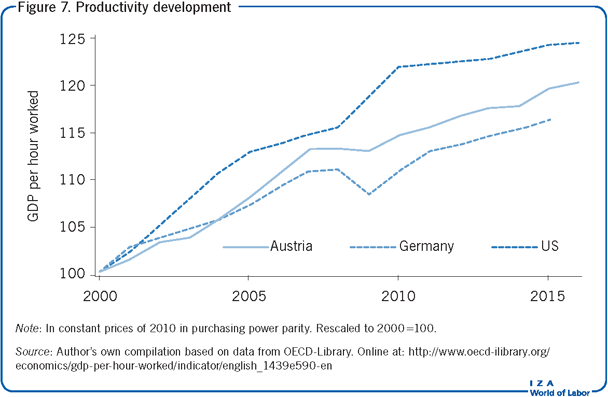
Limitations and gaps
While Austria was one of the first countries to make administrative data available for scientific research, there have been few efforts to expand on this by utilizing the data for policy research. For example, social security data have been used to analyze workers’ behavior, but there is only limited information that permits the analysis of firms’ activities. As a result, researchers currently know very little about who benefits from firm-provided training and how such training translates into productivity gains.
Summary and policy advice
Austria’s economy is transitioning away from sectors with low innovation and toward those with rapid innovation that are skill intensive. This poses a challenge for the country’s education system to provide adequate training for people with few formal qualifications [1]. International comparisons of school performance indicate that more and more Austrian students leave school without sufficient mastery of basic competences.
Furthermore, observers have been noticing for years that high wage taxes reduce Austrian employers’ labor demand. Austria’s overall tax ratio is currently 28% higher than the OECD Advanced Countries average, and labor taxes are the second highest in the EU28 [9]. High labor taxes dampen labor supply and labor demand. The tax wedge, that is, the ratio between the taxes paid by an average single worker without children and the corresponding total labor cost for the employer as a percentage of labor cost, decreased slightly in OECD countries during the crisis. In Austria, on the other hand, it increased; tax reforms in 2015, however, resulted in a moderate decline of about two percentage points. Austrian taxes on capital and wealth are below the OECD average and there are few incentives to move from social assistance to low-paid jobs due to these high labor taxes.
Finally, the performance of the Austrian education system is below the OECD average, which will exacerbate problems in the labor market, especially for young workers with little or no formal qualifications. The labor market integration of recent immigrants is also a challenge. In addition, labor market participation of older people is relatively low, despite increases during the last decade (in 2016, the labor force participation was 49% for workers between 55 and 64 years of age), and, coupled with longer lifespans, could constrain fiscal budgets as the population ages. Reform efforts should thus be targeted at the educational system, at reducing high labor taxes, and at facilitating labor mobility between declining and expanding sectors.
Acknowledgments
The author thanks two anonymous referees and the IZA World of Labor editors for many helpful suggestions on earlier drafts
Competing interests
The IZA World of Labor project is committed to the IZA Guiding Principles of Research Integrity. The author declares to have observed these principles.
© René Böheim